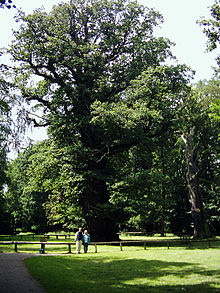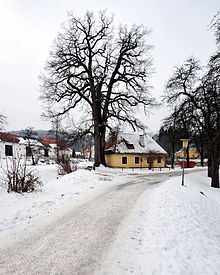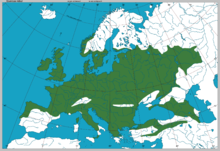English oak
| English oak | ||||||||||||
|---|---|---|---|---|---|---|---|---|---|---|---|---|

English oak ( Quercus robur ), illustration |
||||||||||||
| Systematics | ||||||||||||
|
||||||||||||
| Scientific name | ||||||||||||
| Quercus robur | ||||||||||||
| L. |
The English oak ( Quercus robur L. , Syn. : Quercus pedunculata . Hoffm ) and English oak or German oak tree is called a plant from the genus of oak ( Quercus ) in the family of Fagaceae (Fagaceae). In order to emphasize their affiliation to the oak genus, the hyphen spelling of pedunculate oak is common in botany . The pedunculate oak was " Tree of the Year " in 1989.
distribution

The pedunculate oak is the most common type of oak in Central Europe. It occurs in almost all of Europe and is only missing in the south of the Iberian Peninsula , in Sicily , in the south of Greece , in northern Scandinavia and in northern Russia . Compared to the sessile oak, its distribution area extends far further to the east, as it tolerates a continental climate much better. The distribution of the pedunculate oak extends up to 1000 m in the Bavarian Alps .
The pedunculate oak develops best on nutrient-rich, deep loam and clay soils. Due to its good adaptability, however, it can also colonize alternately moist to wet pseudogley and gley soils . The English oak, which needs light, is being displaced in normal locations in Central Europe by the shade-tolerant, competitive European beech . It is therefore only inventory-building at special locations, i. H. in the periodically flooded hardwood forests of the great rivers, on strict clay soils in oak-hornbeam forests and on nutrient-poor, dry sandy soils in oak-birch forests and oak-pine forests. In the east of the distribution area, the common beech no longer occurs due to the risk of late frost, so that common oaks together with hornbeam , Scots pine and sand birch form the natural forest community there.
Many oak forests in Central Europe are of anthropogenic origin. They are intergrown middle forests , as the pedunculate oak tolerates the periodic placement on the cane better than the common beech. The oaks were also historically promoted specifically because of their valuable wood and their fruits, which are useful as fodder.
In the sense of the megaherbivore hypothesis, however, the extraction of oak by humans in Central Europe is only a substitute for the natural situation. Since the oak can dominate under the influence of grazing , it is argued that this would naturally have been the case before human intervention, because large areas would have been kept open by herbivores and would have provided good conditions for oak regeneration. This is supported by pollen diagrams in which the oak frequently or dominantly appears, for example, during large sections of the Holocene. According to proponents of the hypothesis, this would not be feasible under today's circumstances with the oak as a type of extreme location.
In geological terms, oaks have already been documented from the Tertiary . They can be found in fossil form 12 million years ago, for example in sediments from the Hambach opencast mine in the Rhineland.
description

The pedunculate oak is a 20 to 40 meter high tree and reaches a trunk circumference of up to three meters, in free standing up to 8 meters. Their maximum age is 500 to 1000 years, in exceptional cases up to 1400 years. When young, their bark is smooth and slightly gray-green, glossy, later a thick, deep, longitudinally cracked, gray-brown bark is formed. The buds are blunt, egg-shaped and sit in heap on the shoot ends. The alternate, leathery leaves have only short stalks and are 10 to 15 centimeters long. They are shiny deep green on the top, lighter on the underside and lobed in five to six bays . The pedunculate oak is single- sexed. She reaches the ability to form germinable acorns around the age of 60. It blooms from April to May, the acorns ripen from September to October. The acorns sit in groups of three to five on stems 1.5 to 4 centimeters long (hence the name pedunculate oak) and grow to 3.5 centimeters long. The acorns serve as food for various animals and are spread by them. The jay in particular ensures the spread of the common oak ( jay seeds ) by creating food depots . The pedunculate oak forms a strong taproot ; thanks to its roots it is extremely stormproof. With its roots, it can also open up highly compacted soils in order to reach deep-lying groundwater .
The number of chromosomes is 2 n = 24.
Differences to the sessile oak
The English oak and the sessile oak are very similar. Many systematists and geneticists see the sessile oak as just a local breed of the pedunculate oak. However, there are some differences in distribution and morphology: The pedunculate oak is found mainly in the lowlands and the alluvial forests. There are too few of their fruits on long stalks. The leaves are only short stalked. The leaf base is heart-shaped and eyed. In the middle spreading area of the leaves, the side nerves also end in the bays. The buds of the sessile oak are slightly slimmer than those of the English oak.
Systematics
There are five subspecies:
- Quercus robur subsp. broteroana O.Schwarz : It occurs in Portugal.
- Quercus robur subsp. brutia (Ten.) O.Schwarz : It occurs in southern Italy and on the western Balkan peninsula.
- Quercus robur subsp. imeretina (Steven ex Voronow) Menitsky : It occurs in the western Caucasus region.
- Quercus robur subsp. pedunculiflora (K.Koch) Menitsky : It occurs on the Balkan Peninsula, on Crete in the Crimea and from Turkey to northwestern Iran.
- Quercus robur subsp. robur : It occurs from Europe to Transcaucasia.
Cultivated forms

A selection of cultivated forms of the common oak follows:
- Gold oak ( Quercus robur 'Concordia'): originated in Belgium in 1843; the leaves are golden yellow, the foliage yellowish green in summer. This form is planted less often and can grow to around 13 meters tall.
- Pyramidal oak ( Quercus robur 'Fastigiata'): Like a pyramidal poplar, it grows very tightly upright and very narrow. The tree can reach 20 to 25 meters in height and 1 meter in trunk diameter. Commonly seen in larger parks and formal gardens. A well-known representative is the beautiful oak near Harreshausen .
- Quercus robur 'Filicifolia': The foliage is similar to that of 'Pectinata', but the lobes are very slender and have a curled edge.
- Quercus robur 'Pectinata': it has deeply incised leaves; the lobes are straight and not puckered.
hybrid
- Quercus × turneri ; Crossing Quercus ilex x Quercus robur
- Quercus x bimundorum 'Crimschmidt'; Cross of Q. robur x Q. alba
- Quercus × warei ; Crossing Quercus robur L. f. fastigiata and Quercus bicolor
use
The pedunculate oak is a ring-pored heartwood tree . The yellowish-white sapwood is relatively narrow, the heartwood is light to dark brown in color. The mean bulk density is 0.65 (0.39 to 0.93) grams per cubic centimeter. The oak wood is hard, tough, very durable and easy to work with. It is very versatile: as construction timber , in hydraulic engineering, for railway sleepers and for piles. In interior construction, it is suitable as parquet , for stairs and as furniture wood. High-quality oak wood is processed as veneer or used for barrel construction. The common oak also makes excellent firewood .
In the past, the use of acorns as fodder for pigs and game was just as important as the use of wood. The acorns, which humans can only eat after treatment because of the bitter substances, are very nutritious and contain up to 38% starch . The pigs were driven into the oak forests and fattened with the acorns in good seed years. From this time comes the saying The best ham grows on the oaks. Acorns and oak leaves are harmful to cattle and horses due to their high tannin content.
Another use was that of the bark as a tannery . For this purpose, the pedunculate oak was cultivated as coppice , so-called tunnels , harvested every 15 to 20 years, the trunks curled and the bark peeled off. The dried bark has a tannic acid content of 8 to 20%.
Medicinal plant
The dried bark of the young twigs and stick rashes serve as the drug . The pharmaceutical drug name is Quercus cortex ( Latin for oak bark; old: Cortex Quercus).
The bark usually contains 10% (up to 20%) tannins, which are primarily catechin tannins (oligomeric proanthocyanidins). The European Pharmacopoeia (Ph. Eur.) Calculates the catechins as pyrogallol and requires a minimum content of 3%. There are also ellagitannins or complex tannins, e.g. B. Flavanoellagitannins and quercitol and triterpenes. Up to 15% of the tannin is present in the leaves and in fruits that are still green.
Externally, full baths or compresses with preparations made from oak bark are used, especially for inflammatory skin conditions (not for weeping eczema / extensive skin damage). Local areas of application for oak bark are slight inflammation in the mouth and throat as well as in the genital and anal area. Internally, oak bark is used for unspecific, acute diarrheal diseases, for example as a tea preparation.
Diseases and pests
- mildew
- Leaf spot ( Septoria spp.)
- Leaf tan ( Apiognomonia quercina )
- Gall mosquitoes ( Macrodiplosis volvens KFFR.)
- Phytophthora spp.
- Honey fungus ( Armillaria spp.)
- Spindeliger Rübling ( Collybia fusipes )
- Two-spotted oak splendor beetle ( Agrilus biguttatus )
swell
Documentary film
- The tree of trees. Mysterious journey into the world of oaks , TV documentary by Herbert Ostwald , Germany 2004.
literature
- Joachim Krahl-Urban: The oaks. Forest monograph of the sessile oak and the English oak . Parey, Hamburg / Berlin 1959.
- Heinrich Spiecker : To control the growth in thickness and the cleaning of branches of sessile and English oak (Quercus petraea (Matt.) Liebl. And Quercus robur L. ) . Series of publications of the state forest administration of Baden-Württemberg, Volume 72. Forestry experimental and research institute, Freiburg im Breisgau 1991.
- Gregor Aas : Investigations into the separation and cross-ability of English oak and sessile oak (Quercus robur L. and Quercus petraea (Matt.) Liebl. ) . Dissertation. Munich 1989.
- Dietrich Frohne: Medicinal Plant Lexicon . 8th edition, Wissenschaftliche Verlagsanstalt, Stuttgart 2006, ISBN 3-8047-2316-0 .
- K. Hiller, MF Melzig: Lexicon of medicinal plants and drugs. 2nd Edition. Spectrum Academic Publishing House, 2010, ISBN 978-3-8274-2053-4 .
- Hubertus Wachter: The pedunculate oak (Quercus robur L.) of Slavonian origin in Westphalia and the Lower Rhine. Kessel, Remagen-Oberwinter 2011, ISBN 978-3-941300-42-2 .
- Christian Küchli, Jörg Müller (Illustrator): The best hams grow on the oaks. Ten intimate tree portraits . Im Waldgut, Frauenfeld 1987, ISBN 3-7294-0047-9 ; New edition: AT, Aarau 2000, ISBN 3-85502-714-5 .
Individual evidence
- ↑ Bernd Ullrich, Uwe Kühn, Stefan Kühn: Our 500 oldest trees, Munich 2012, p. 13
- ^ Erich Oberdorfer : Plant-sociological excursion flora for Germany and neighboring areas . 8th edition. Verlag Eugen Ulmer, Stuttgart 2001, ISBN 3-8001-3131-5 , p. 317.
- ↑ Rafaël Govaerts (ed.): Quercus robur. In: World Checklist of Selected Plant Families (WCSP) - The Board of Trustees of the Royal Botanic Gardens, Kew . Retrieved April 13, 2020.
- ↑ a b c Roth, Daunderer & Kormann: Poison Plants, Plant Poisons, NIKOL Verlag, 5th edition, 2008. ISBN 978-3-86820-009-6 .
- ↑ a b c Holm & Herbst: Botany and Drug Science , DAV, 9th edition, 2010. ISBN 978-3-7692-5240-8 .
- ↑ a b Bettina Rahfeld: Microscopic Color Atlas of Plant Drugs , Spectrum Academic Publishing House, 2009. ISBN 978-3-8274-1951-4 .
- ↑ http://www.baumportal.de/Stieleiche.htm
- ↑ Dying oaks ( Memento from February 1, 2012 in the Internet Archive )
Web links
- Quercus robur inthe IUCN 2013 Red List of Threatened Species . Posted by: Participants of the FFI / IUCN SSC Central Asian regional tree Red Listing workshop, Bishkek, Kyrgyzstan, 2007. Retrieved September 21, 2013.
- English oak. In: FloraWeb.de.
- English oak . In: BiolFlor, the database of biological-ecological characteristics of the flora of Germany.
- Profile and distribution map for Bavaria . In: Botanical Information Hub of Bavaria .
- Quercus robur L. In: Info Flora , the national data and information center for Swiss flora . Retrieved October 3, 2015.
- Distribution in the northern hemisphere according to Eric Hultén
- Thomas Meyer: Data sheet with identification key and photos at Flora-de: Flora von Deutschland (old name of the website: Flowers in Swabia )
- Description of the oak at Baumkunde.de
- The Pedunculate Oak - Tree of the Year 1989 at Kuratorium Baum des Jahres e. V.
- Article on the species at Stiftung Unternehmens Wald
- The pedunculate oak in German and Palatinate folklore at heimat-pfalz.de











